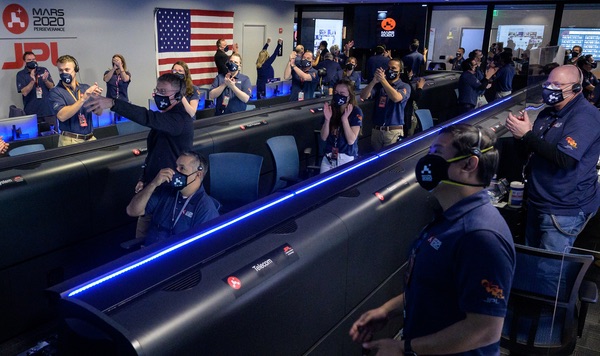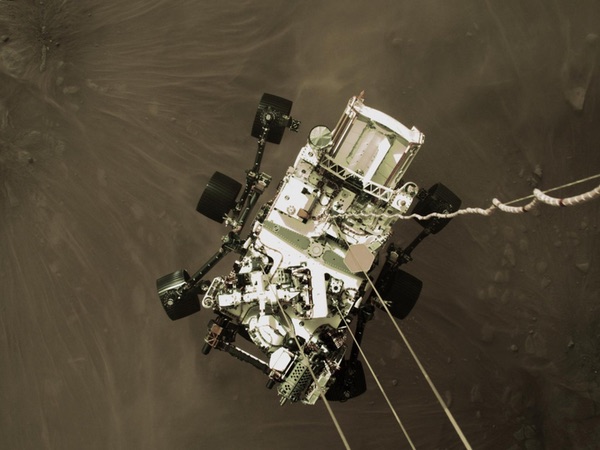It only looks easy: Perseverance lands on Marsby Jeff Foust
|
| “You may or may not have seen, in the last row, some bent COVID protocols,” Zurbuchen said after the post-landing celebration. “I had to hug some people. Sorry for that.” |
The same may be true for Mars landings. On Thursday, NASA’s Perseverance spacecraft arrived at Mars. As with the Curiosity rover in 2012, NASA played up the risks of landing, including the “seven minutes of terror” during entry, descent, and landing (EDL), where even one misstep could be fatal. “There’s no go-backs, there’s no retries. It’s a difficult and dangerous part of the mission, and I think you always have to respect that,” Matt Wallace, deputy project manager, said at a briefing a day before the landing.
“I think we’ve done everything we can to make it successful,” he added, “and we’ll see how it goes tomorrow.”
On Thursday, all eyes turned to mission control as data flowed back from Perseverance. That control room looked a little different than past missions because of COVID-19, with fewer people, all wearing masks. (If they were nervous, they could only figuratively bite their nails.) Swati Mohan, the guidance and control operations lead, announced milestones as the spacecraft jettisoned its cruise stage and began its entry into the Martian atmosphere.
Some who watched the feed compared the callouts of those EDL events with the timeline, looking for any signs of something going wrong. Those signs never came. “Touchdown confirmed,” she announced at 3:55 pm EST as the signals confirming a safe landing arrived on Earth, nearly eleven and a half minutes after their transmission from the surface of the Red Planet. “Perseverance is safely on the surface of Mars, ready to begin seeking the signs of past life.”
There were cheers and jumps for joy in the control room, similar to past landings but perhaps a little more muted given COVID-19. “You may or may not have seen, in the last row, some bent COVID protocols,” Thomas Zurbuchen, NASA associate administrator for science who observed the landing from the back of mission control, said at a post-landing briefing. “I had to hug some people. Sorry for that.”
 The Mars 2020 mission team celebrates as the first images from the Perseverance rover are returned minutes after landing. (credit: NASA/Bill Ingalls) |
The flawless landing didn’t mean the landing was easy. A huge team worked for years on the spacecraft and its various systems, taking advantage of those demonstrated on the Curiosity landing. Perseverance, though, was not an identical twin of Curiosity, but rather an upgraded version more than 100 kilograms heavier, with changes ranging from a different set of instruments to wheels redesigned to better handle the wear-and-tear of driving on the rough Martian surface.
It was also equipped with new landing technologies, in particular terrain relative navigation. During descent, a camera on the rover took images of the Martian surface and compared them to a map onboard. That allowed the rover to determine where it was and steer to a location that engineers previously determined was safe for landing.
| “The system managed to find a nice blue spot in the midst of all that red, all that death that’s out there for us. We found a parking lot,” Chen said. |
That technology was critical for landing in Jezero Crater, an ancient lakebed with remains of a river delta that scientists believe could contain biosignatures of ancient Martian life. “When I look at it from a landing perspective, I see danger,” said Allen Chen, EDL lead for the mission, during a briefing last month. “The site is replete with steep cliffsides that happen to run right through the middle of the landing site, there’s sand, there’s boulders, there’s impact craters. All these would be a bad day if we touch down on them.”
Without terrain relative navigation, along with a new “range trigger” that provides better control over the release of its parachutes, “we just could not go to Jezero,” he said.
Both technologies came through for the landing of Perseverance. At the post-landing briefing, Chen showed a color-coded map of the landing site, with safe landing locations in blue and unsafe ones in red. “We landed in an area that’s relatively rugged,” he said. “The system managed to find a nice blue spot in the midst of all that red, all that death that’s out there for us. We found a parking lot.”
The successful landing prompted elation, but also relief. During a session of The Planetary Society’s Planetfest ’21 online conference earlier this month, Rob Manning, chief engineer of JPL and a veteran of past Mars landings, said that “terror” probably wasn’t the best word to describe the experience of EDL. “It’s probably more like anxiety: deep, deep, deep anxiety.”
“When you see us cheer” after a successful landing, he added, “it’s not happiness. It’s relief, deep relief.”
There’s also deep relief for NASA’s long-term Mars exploration program. NASA’s future Mars exploration program is, for the next decade, tied closely to sample return, which begins with Perseverance caching samples that two later missions will collect and return to Earth (see “The future of Mars exploration, from sample return to human missions”, The Space Review, December 7, 2020.) Had Perseverance failed to find that Martian parking lot, NASA’s future Mars plans would have been as shattered as the rover itself.
“It’s not adding stress,” Zurbuchen insisted as a pre-landing briefing when asked if the agency was feeling additional pressure for this landing compared to past ones. “We’re entirely focused on one thing right now, which is the successful landing.”
The successful landing, though, allows NASA and the European Space Agency to proceed with initial “Phase A” studies of both a Sample Retrieval Lander and Earth Return Orbiter, those two future missions needed to bring those samples back to Earth. That includes addressing dozens of findings and recommendations from an independent review last fall, which suggested the program might not be ready to launch in 2026 as currently planned and may need more money.
“We’re taking the findings and recommendations from that report very seriously,” Bobby Braun, Mars Sample Return program manager at JPL, said before the landing. He expects that work to be complete when the Phase A studies are wrapped up this fall.
| “Now that we’re on the ground,” said Glaze, “the fun really starts.” |
The excitement, or relief, of landing seems to have been met with something of a shrug from the general public. There was plenty of news coverage of the landing itself, but it soon faded. It didn’t help that, after a briefing Friday afternoon, less than 24 hours after the landing, JPL went radio silent for the weekend, offering no updates on the progress of deploying and checking out instruments and other rover systems. A lack of imagery from the rover, a break from the practice of past missions, riled up some space enthusiasts (see “NASA tests the perseverance of some space enthusiasts”, The Space Review, this issue.)
As this article was being prepared for publication, NASA was heavily promoting a briefing Monday afternoon that’s widely expected to include a first-of-its-kind video of EDL, taken using what basically were GoPro cameras mounted in several locations on the spacecraft.
That EDL video, while potentially entertaining and enlightening, is not the point of the mission. “It turns out, after landing, it’s not over. In fact, it’s just beginning. The science mission is just beginning,” said Jennifer Trosper, deputy project manager, at a pre-landing briefing.
That science mission won’t begin in earnest for weeks—allowing time for both checking out the instruments as well as 30 days set aside for flight tests of the small Ingenuity helicopter that accompanied Perseverance—but will last for many years if all goes well, looking for evidence of past life. “Now that we’re on the ground,” said Lori Glaze, director of NASA’s planetary science division, “the fun really starts.”
But fun is too much for some people. “I love these mission control people. But why do they celebrate like this?” asked Greg Kelly, an anchor for Newsmax, a right-wing television network, in a tweet that included a picture of the control room after Perseverance’s landing. And, in a followup, he demanded “NO MORE CELEBRATING until we do something really cool, like making a space ship that can go The Speed of Light.” (Kelly’s Twitter feed looks like a parody concocted by the publishers of The Onion, but is apparently legit. Fortunately, should NASA successfully violate the known laws of physics, “DRINKS ARE ON ME!”)
Kelly’s protestations aside, it’s understandable that NASA wants to celebrate, and even hype, the landing of Perseverance. Placing a one-ton fully instrumented mobile laboratory on the surface of another world in a precise location requires tremendous skill, expertise, hard work, and money (the Mars 2020 mission cost $2.4 billion just through launch, with another $300 million budgeted for its first Martian year of operations.) It’s an achievement no other nation has equaled. Perhaps the biggest problem with landing on Mars is that NASA makes it look easy.
Note: we are temporarily moderating all comments submitted to deal with a surge in spam.
